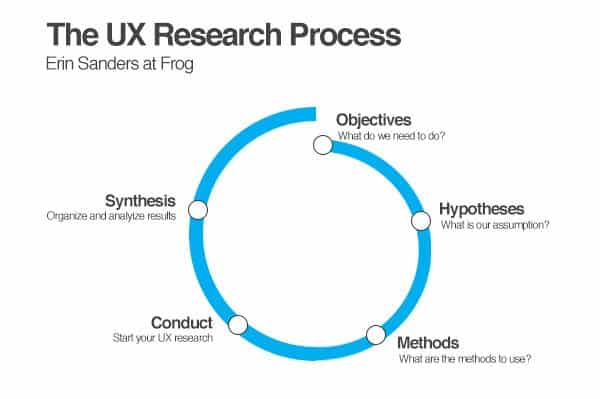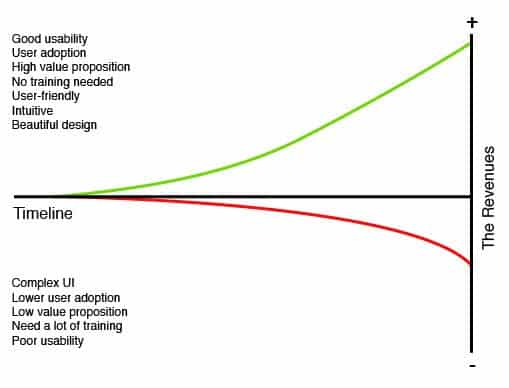The Price of Not Doing a Proper UX Research
When it comes to UX research, business owners and managers freak out to implement as they eager to invest the precious project time in production stages rather than thinking and research ideas. However, this puts the project in the trap of unpredictable outcomes in terms of the user experience which may have a negative impact on the final product or service delivery. The UX research focuses on understanding the user behavior, needs, experience, and motivations through using the UX research qualitative and quantitate methods. The UX research is also known as design research.
“the process of understanding the impact of design on an audience.” Mike Kuniaysky
The UX research is very similar to any type of research such as the marketing research, it is placed in an early stage in the design thinking process and allows us to start the production phase with a clear insight about the end user, the problems that need to be addressed, and ensures that the final solution is usable and meet the user needs and expectations. It starts with assumptions about the user rather than facts, which are proven through the research phase.
Related articles:
- How to Conduct a Successful UX Research for Your Design Project
- Using Inductive Reasoning in User Experience Research
- Guerrilla User Experience for Quick, Low-Budget Research
- Using Mind Maps to Track User Experience
However, what are the implications of neglecting the UX research phase, it will surely save time and money in the short run, but what about the long run? Below are common issues that may occur when a company puts aside the UX research based on a holistic view of the project timeline; before, during, and after the product.
Wasted Development Time, Effort, and Cost
When the team dives directly into the production, it considers the knowledge they have as true facts rather than assumptions that need to be validated. When the product is tested by real users, the concerns and problems start to flow which means more rework to do by both production team. This can be due to multiple cases such as:
- The initial assumptions about the user are completely or partially wrong, it is mostly personal opinions and biased ideas.
- The final product is not user-friendly as the wrong assumption reflects on both the form and function of the product
- The product features are confusing for the end user. For example, the application navigation is not clear enough for the user.
- The product has amazing feature that no one uses it or want it
- This ends up to either getting stuck in the application or just abandon it completely

The above scenarios end up with a lot of rework with increases the cost, time, and effort spent in the production process. According to the Usability.org, up to 15% of IT projects are abandoned and at least 50% of a programmers’ time during the project is spent doing rework that is avoidable (Guerrilla User Experience for Quick, Low-Budget Research).
High Customer Support Bill
After the above mess, if the company is lucky enough to keep any of their consumers on board, the users will keep struggling while using the product and keep contacting the customer support to fix these problems. For example, one of the banks is having a terrible website experience, consumers can’t find their accounts information easily, and they end up by called the customer support. Hence, the cost of the customer support increases and the workload increase on the existing customer support employees.
Avoiding the UX Research Leads to Less Revenues
On the short run, it is cheaper to start with the project without taking time for UX research, brainstorming solutions, and building a short-term strategy for the new product development (NPD) process. However, this is not the same on the long-term based on two scenarios:
For digital products such as websites, companies aim to improve their conversion rate of their websites. It is a smarter and more efficient to increase the conversion rate rather than increasing the traffic. The conversion ratio varies based on the goals that need to be archived. It can be making more sales, visiting more pages, or clicking more ads. The more goals achieved by fewer users increase the conversion rate of the project and subsequently revenues. If the users are facing terrible experience when visiting a website, this will negatively reflect on the conversion rate and reduce the overall revenues that can be achieved by the current users.

For both product and service, if the consumer is facing a bad user experience, this reflects negatively on the revenues as they will avoid using the service rate it badly when it comes to recommending it to friends or other consumers. The word of the mouth is one of the most efficient ways to promote products, and having this bad experience will eventually reflect negatively on the overall rating for the product.
Failing to Achieve Empathy and User Loyalty
The empathic design aims to address the user needs and solve their problems by putting them in the heart of the design process. This can only be achieved by clearly understand the end users, their needs, and current experience. Without having an accurate, there will be no chance to achieve empathy as the final product will wrongly address the user needs or neglect it completely.
In business, the loyal consumer presents an important target to achieve as the consumer will keep using the service again and again. However, with the bad user experience, the company will quickly lose the consumers, which will eventually lead to project failure.
Falling Behind the Market Competitiveness
In the competitive markets, the business has two paths to take, either compete or die. It is not an option to stand still while others are targeting improving their market competitiveness. The design process plays an essential role to improve the business competitiveness through multiple factors. One of these factors is the user experience, which ensures that the users are satisfied with the product or the service and will use it again.
Honestly, the user experience lays in the heart of the factors that can improve the business market competitiveness. It doesn’t matter how much innovative the product is, or the investment in marketing campaigns and promotions. If the users come to use the product and face a bad user experience than other competitive products, they will not use it again which lead to more product failure.
In sum, The UX research or the design research presents an important stage in the product development as it is the base of all the following development stages as highlighted in different design thinking processes such as the d.school design thinking, IDEO design thinking, and double diamond model. However, many managers see the UX research as an overall phase that adds cost, time, and effort to the project. While this is true on the short-term, the consequences of not applying the UX research can be catastrophic for the project and business success. The above five points are part of the price that the business will pay if the UX research is not considered at the beginning of the project.






